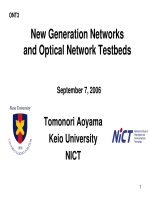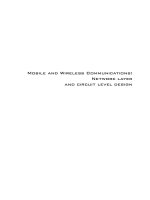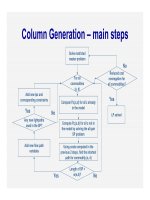Column Generation for WDM Optical Network Design phần 1 pot
Bạn đang xem bản rút gọn của tài liệu. Xem và tải ngay bản đầy đủ của tài liệu tại đây (126.44 KB, 13 trang )
Column Generation for WDM
Column Generation for WDM
Optical Network Design
Optical Network Design
S. Raghavan
Daliborka Stanojević
Robert H. Smith School of Business, University of Maryland, College
Park
Outline
• Basic concepts
• Problem Definition
• Background
• Branch-And-Price (BP) Algorithm
– Column Generation (CG)
– Branching Strategy
• Preliminary Computational Results
• Concluding Remarks
optical fiber
Basic Concepts
in WDM optical network design
• Optical fibers interconnect
nodes in the network
optical fiber
• WDM – multiple signals
carried over the same fiber
at different frequencies
(wavelengths)
1
λ
2
λ
3
λ
Basic Concepts
in WDM optical network design
Node Equipment
• Single signal example
A DC B
intermediate nodes (no E/O
O/E conversion necessary)
signal origin node signal destination node
Transmitter - - Receiver
• Assumption: All nodes are equipped with wavelength
converters ⇒ we do not have to worry about
wavelength assignment (so, signal A → B could be sent
on different wavelengths on each of the segments A →
C, C → D, D → B)
Basic Concepts
in WDM optical network design
Notion of lightpaths and logical topology
•Def: Lightpath (lp) is a path in the physical topology used to
carry traffic requests. It requires a transmitter at the path origin,
and a receiver at the path destination (lps in the example: A →
B, A → C, B → D)
•Def: Logical Topology is a collection of all lps established
in the physical layer of the optical network.
A
D
C
B
- Transmitter
- Receiver
- Fiber with
capacity of 1 TU
Traffic requests
:
A → B 0.3 TU’s
A → C 0.9 TU’s
A → D 0.2 TU’s
Problem Definition
• Given physical topology of the WDM optical network:
– Number and capacity of fibers
– Capacity of lightpaths that can be created on the fibers
– Number of transmitters and receivers at each node
– Traffic matrix (demand between all pairs of nodes)
• Determine logical topology (routing of lightpaths over the
physical topology) and routing of traffic flow over the
logical topology so that network performance is optimized.
Additional Assumptions
• No flow bifurcation for a given traffic request
• Wavelength conversion is possible (at no cost) at all
nodes in the network
• Performance measures considered:
– Lost traffic
– Quantity / cost of node equipment
– Average hop distance over all flow paths in the network
Background
• Exact MIP formulations for WDM OND problem are
too difficult to solve
– Banerjee and Mukherjee (2000) - WDM OND with
wavelength conversion (problems solved include networks
with up to 20 nodes, at most 1 fiber between pairs of nodes,
and pre-specified set of lightpaths)
– Krishnaswamy and Sivarajan (2001) – WDM OND without
wavelength conversion (problems solved include networks
with up to 6 nodes)
• Large number of heuristic algorithms – an extensive
survey – Dutta and Rouskas (2000)
Background
• The WDM OND problem with wavelength conversion
can be seen as a 2-layer ODI MCF problem with node
degree constraints – a generalization of a standard ODI
MCF problem
• ODI MCF problem can be efficiently solved in
networks of moderate size using branch and price and
cut algorithm – Barnhart et al. (2000)
Path-based formulation for the WDM
OND problem
•PB-MIP1
),(1
0
);,(
:
),(),(
:
),(),(
);,(:
)(:
)(:
),(
),(),(
dsHf
zfTX
ljiLX
VjX
ViX
toSubject
HTMin
ds
p
ds
p
pzp
ds
p
ds
z
zljiz
z
jzDz
j
rz
izOz
i
tz
ds
dsds
∀=+
∀≥−
∀≤
∈∀∆≤
∈∀∆≤
∑
∑
∑
∑
∑
∑
∈
∈
=
=
∀
zRX
dszfX
sconstraAdditional
zBX
dspBf
z
pzp
ds
pz
z
ds
p
∀∈
∀≥−
∀∈
∀∈
+
∈
∑
1
:
),(
1
1),(
),(,0
int
),(,
Path-based formulation for the
WDM OND problem
•PB-MIP2
zGX
zgGYfT
ljidLYfT
VjbYfT
ViaYfT
vdualtoSubject
HTMin
zz
zzz
pzpds
ds
p
ds
zljiz
ljiz
zljipzpds
ds
p
ds
j
jzDz
j
rz
jzDpzpds
ds
p
ds
i
izOz
i
tz
izOpzpds
ds
p
ds
ds
dsds
∀=+
∀=++
∀≤+
∈∀∆≤+
∈∀∆≤+
∑
∑∑
∑∑
∑∑
∑
∈∀∀
∈∈∈∀∀
==∈∃∀
==∈∃∀
∀
1
1
);,(
.:
:),,(
),(),(
);,(:
);,(
);,(::),,(
),(),(
)(:)(::),,(
),(),(
)(:)(::),,(
),(),(
),(
),(),(
zRX
dszvfX
sconstraAdditional
zZX
dspBf
dswHf
zrfTX
z
z
pzp
ds
pz
z
ds
p
dsds
p
ds
p
ds
z
pzp
ds
p
ds
z
∀∈
∀≥−
∀∈
∀∈
∀=+
∀≥−
+
∈
+
∈
∑
∑
∑
1
:
),(
1
1),(
),(),(),(
),(
:
),(),(
),(,0
int
),(,
)
,(1
0
Column Generation for PB-MIP2
• Reduced cost for any flow path variable is:
• To identify potential new flow paths we can solve the
following problem for each commodity:
•Or
• Can be solved as a shortest path problem in a graph
with edges represented by lightpaths and edge costs
defined by term
),(),(),(),(
);,(
);,(
),(),(),(
)(
ds
pz
z
dsds
zz
ds
zlji
lji
ds
j
ds
i
ds
wvTrgTdTbTaT −++−−−−
∑
∑
∈∀∈∀
∑
∑
∈∀∈∀
∀
++−−−−
pz
z
dsds
zz
ds
zlji
lji
ds
j
ds
i
ds
z
vTrgTdTbTaTMin )((*)
),(),(),(
);,(
);,(
),(),(),(
∑
∈∀
∀
pz
dsz
z
PMin
),(,
),(, dsz
P
Column Generation (cont.)
SOLUTION:
• For any new lightpath z, the term can be reduced to:
• As we are looking for new lightpaths that will minimize the
term , we can solve the following for each pair of
nodes:
or
• Can be solved as an all-pair shortest path problem with
edge costs defined by
),(, dsz
P
∑
∈∀
−−−
zlji
lji
ds
j
ds
i
ds
dTbTaT
);,(
);,(
),(),(),(
),(, dsz
P
∑
∈∀
−−−
zlji
ljiji
dbaMin
);,(
);,(
}{
∑
∈∀
−
zlji
lji
dMin
);,(
);,(
}{
lji
d
);,(
−









